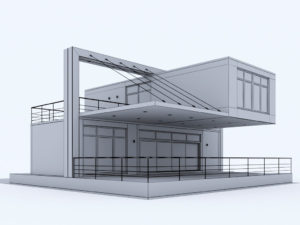Shipping Container



Containers are an innovative trend in architecture and it is already common to see beautiful and functional places using these naval module structures as the basis either for housing or commercial real estate construction. The work is fast, sustainable and with an industrial inspiration that provides an environment with an extra charm for users.
The idea of turning containers into buildings began in the early 1990s, in England. Some architects saw the abandoned modules and thought about new ways to employ them after no longer used for cargo transportation on tramp steamers. However, the inspiration for this use may be older. There are 1850 patent applications for the purpose of transforming old train cars (which are almost of the same format) into fixed restaurants.
Why build containers?
Fast and clean work, a conventional construction usually generates a lot of dirt. Repurposing a container into a building usually takes six or seven months, whereas a conventional construction of the same size may take one year.
Besides faster construction and eco-friendliness, shipping container building assumes another advantage over traditional construction: walls prepared for receiving plumbing, electric power system and also, insulation systems application, whose ideal type can be decided depending on environmental criteria as climate and manufacturer region.
Less environmental impact
In addition to vacating a huge space in warehouses (where they would probably stand still until they rust), the reuse of containers has reduced the use of wood in buildings. The production of these materials consumes natural resources and releases greenhouse gases. Thus, reducing their application helps to decrease the environmental impact of the work. This method also results in less debris and therefore, its operation prevents the accumulation of waste earmarked for landfill at the end of the construction. For those who want to follow this sustainable model, the building project also enables the implementation of renewable energy sources such as solar and wind power, besides harvesting and filtering rainwater.
Mobility
In some buildings, it is possible to make foundation piers in the four points of each container, so it can be removed and taken to other places, allowing the construction of restaurants or stores in special events. Building working made out of containers is flexible and to allow assemblies in different combinations.
Containers are extremely strong, what permits they can be stacked up to seven units when they are fully loaded.
In architecture, they have been proven as a versatile building material, from simple temporary disaster relief housing to luxury hotels, with diversified arrangements providing flexibility.
Low Cost
Container construction costs up to 20% less on average compared to the cost of the convention construction process.
Highlighting a detail in all of these advantages, the construction made out of shipping containers is also earthquake and hurricane resistant.
Click here to add your own text
Click here to add your own text
Click here to add your own text
Click here to add your own text
Click here to add your own text
Click here to add your own text
Click here to add
your own textClick
Click here to add your own text
Click here to add your own text
Click here to add your own text
Click here to add your own texttext
Click here to add your own texttext
